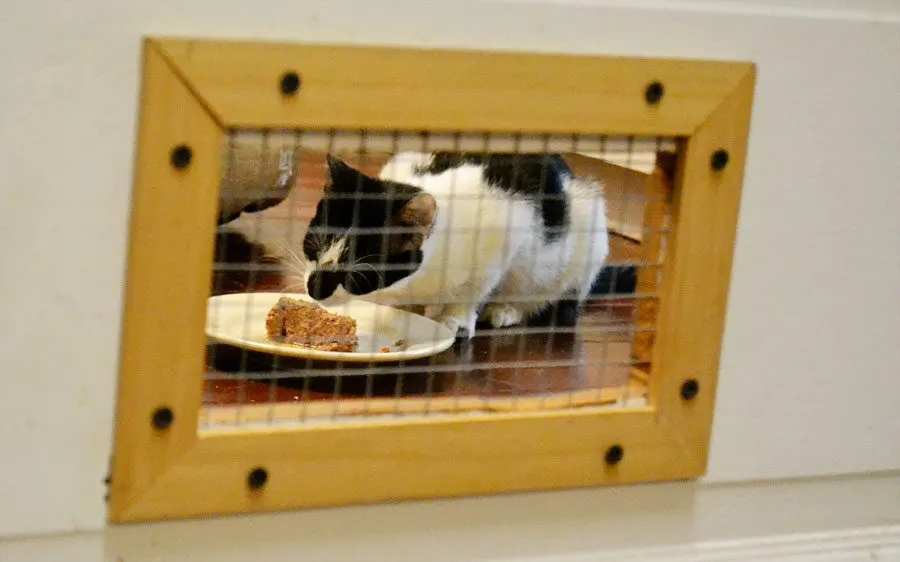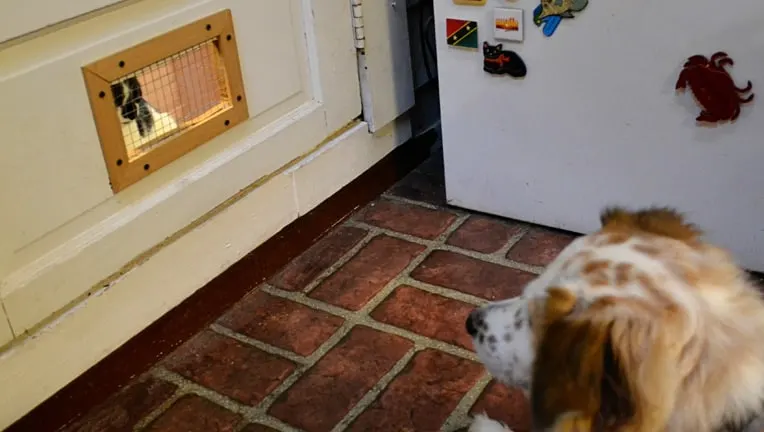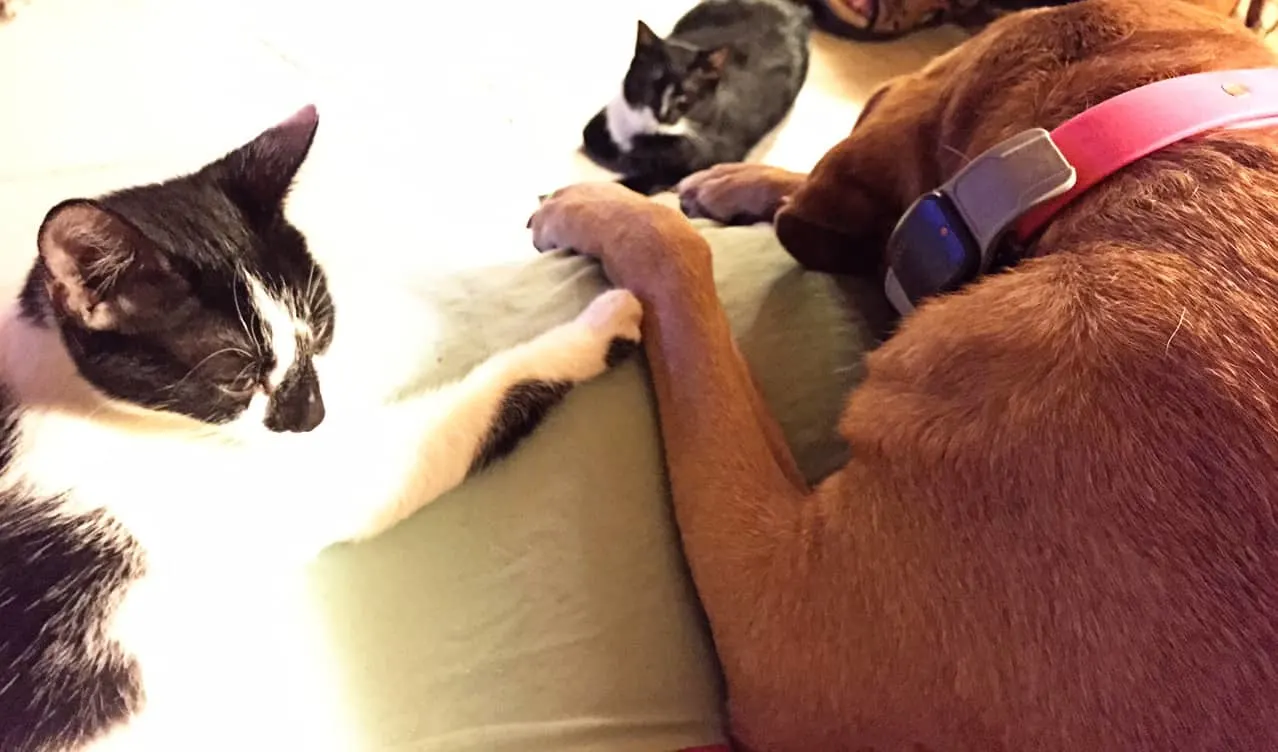Are you considering adding a kitten to your cat household? Congratulations! Get your kitten and your resident cat off on the right paw. If you’re wondering how to introduce a kitten to a cat, we’ve got 10 easy steps you can take to safely accomplish this meet and greet and begin their new relationship.
Here are 10 steps you can take to safely and successfully introduce your new kitten to your resident pets!

1. Confine your new kitten to a small room for the first few days.

Your new cat may feel overwhelmed by the size of her new home so a safe room–usually a small bathroom–can be a great way to help her feel safe.
When we added kitten Ochi to our family, we outfitted our bathroom with a cat tree, scratcher, toys, and a cat bed to accompany the litterbox and bowls. (See more details in our post on how to set up a safe room for your new kitten or cat.)
Ochi did not for her first 10 days at our home. Since she had ringworm when we adopted her, Ochi stayed separate from our other pets a bit longer than we’ve done in the past but we would have kept her separate in the safe room for at least five or six days regardless.
The time apart allowed her to relax, gave us time to slowly transition her food, switching her from her shelter diet to the same diet as our other cats, and, just as importantly, to give our resident pets time to get to know her through the safety of a closed door.
Ochi also had a low window for her first peek into the outside world (her shelter for the past three months didn’t have windows).

2. Allow your resident pets to sniff under the door.
After your new kitten has had a day or two to catch her breath, allow your resident pets to “meet” her with an under the door sniff.
3. Treat your resident cats.
When you step out of the new kitty room, toss a treat to your curious resident cat…and show them that good things happen when the new kitty is around!
4. Feed your kitten near the door–and feed your resident cat on the other side of the door.

At first, keep the bowls some distance from the door itself but, as they become more and more familiar with each other, move the bowls closer to the door.
They can begin to associate the good feelings of mealtime with their soon-to-be sibling(s) on the other side of the door.
We have a vent covered with hardware cloth in one of our doors so after a few days of feeding time behind closed doors, we graduated Ochi to the room with the vent in the door and did the feeding time by this vent.
5. Transfer their scent through brushing.
Brush the “boss” cat in your household then brush the other resident pets then, finally, your new cat.
Once you’ve brushed your new cat, return to the other cats and brush them, transferring the kitten’s scent to their own fur.
Because Ochi had ringworm, we had to skip this step until we had the all-clear from our vet but we’ve done this successfully in the past with Lucky and Inca.
6. Change litterboxes.

We switched Ochi’s litterbox to our laundry/litterbox room and moved one of the resident litter boxes to the new kitten room, to further acquaint everyone with each other’s scents.
The resident cats still had two other litterboxes to use so there wasn’t a risk of Lucky and Inca deciding they weren’t going to use this kitten box–but this gave them a good opportunity to really get to know Ochi’s scent without a face to face confrontation.
7. Change places.
After everyone’s doing well with steps 1-6, swap places!
We moved Ochi into our bedroom and left the bathroom door open for Lucky and Inca to explore, while Ochi was exploring the bedroom.
8. Consider a visual screen.

John cut a hole in the lower portion of the door that separates our storeroom (adjacent to the bathroom) and the rest of the house then covered that hole with screen wire.
Ochi was able to see our other cats and dogs but there was no risk any squabble. This is a great way to introduce cats and dogs without risk. If you have a screened door you can install temporarily inside the house, that’s a great option, too!
Introducing your new kitten to a dog? We have tips for that, too!
9. Give your new kitten plenty of places to hide.
Be sure your new kitten has plenty of options for hiding, whether that’s a tunnel or cat cave.
Also, if your house includes dogs, be sure your kitten has amble opportunities to get up off the floor onto chairs and tables.
10. Supervise the early interactions.

Ochi and Irie, just four days after Ochi left her “safe room.”
With our dogs on leash, we let Ochi out to explore the house. The reaction? After a week of seeing and sniffing Ochi through the door, the reaction was just “oh, yeah, it’s you.”
The dogs sniffed Ochi then went back to their naps.

Lucky immediately wanted to play with his favorite wand, and Ochi soon joined him. Inca was the slowest to come around, preferring to stay in my office for the first few days but, little by little, greeting Ochi on her own timeline.
We’re still careful to pay extra attention to the resident pets, petting them rather than Ochi when they’re all together.
We’re also sure to spend some quality alone time with each one daily, doing the activities they enjoy the most, whether it’s sitting with Inca on my lap in the office or brushing Lucky by the sink. We want to show everyone that they’re not being replaced in our hearts by this new arrival, just that our family–and our love for them all–is growing larger.
The time we spent slowly introducing Ochi to the rest of the family was a great investment in her future, both in terms of her relationships with our other pets and her feeling of security in her new home.
- 🎉 GIVEAWAY: Lord of the Pets Portrait of Your Cat! - November 26, 2024
- Review: Lord of the Pets Cat Portraits! - November 26, 2024
- Cat Adoption: FAQ You Might Have - June 28, 2024
